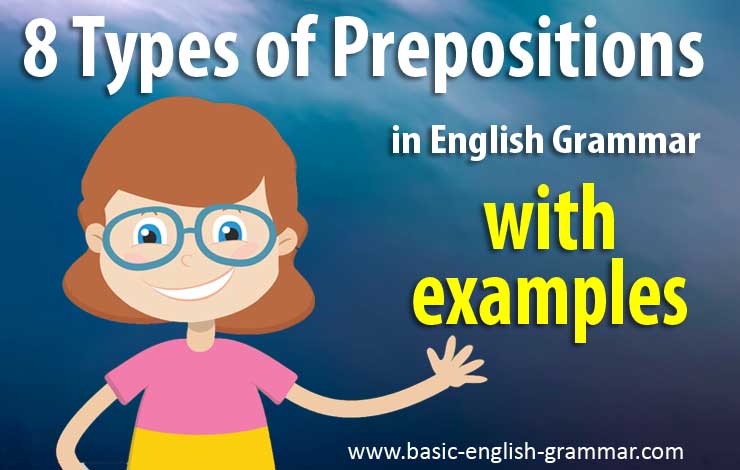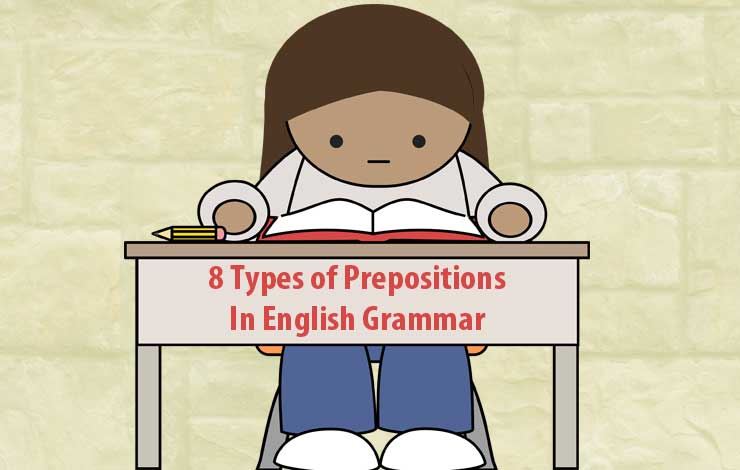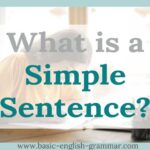8 Types of Prepositions in English Grammar With Examples: The 8 types of prepositions in English grammar with examples include prepositions of time, place, movement, manner, agent or instrument, measure, source and possession.
I will define the types of prepositions according to their usage or function in English grammar and also I will give several examples of these prepositions in English sentences.

8 Types of Prepositions With Examples
- Preposition of time
- Preposition of place
- Preposition of movement
- Preposition of manner
- Preposition of of agent of instrument
- Preposition of measure
- Preposition of source
- Preposition of possession
Before we look at the 8 types of prepositions according to their usage or function, we need a brief definition of a preposition.
Definition: A preposition consists of a word or a group of words that demonstrates the relationship between a noun or a pronoun with another word in the sentence.
A preposition adds extra information to sentences such as, direction, place, time, movement, manner, agent, measure, source and possession. A preposition is usually a short word which is normally placed in front of nouns.
1. Prepositions of Time
Prepositions of time usually indicate when something happens, happened or will happen in the future.
There are several prepositions of time such as, at, on, in, before, during and after.
Here are several examples of prepositions of time!
- David was born on August 8, 2001.
- David was born at 4am in the morning.
- David was born during the holidays of 2001.
- David was born after our hottest summer.
- David was born in 2001.
- David was born before our trip to England.
Note: There are some rules that will help you place the right preposition in the right place when it comes to time.
Rule 1 – use in when you refer to years, months, seasons, centuries and time of day.
For example: It is always hot in January.
Rule 2 – use on when you refer to days, dates and specific holidays.
For example: We go to church on Sunday.
Rule 3 – use at when you refer to time exceptions and festivals.
For example: I work best at night.
2. Prepositions of Place
Prepositions of place usually indicate position and they are easily discernible. The three most common prepositions of place are on, at or in.
What makes this interesting is that these three prepositions are used to indicate both time and place. But as I said before, they are easily discernible.
Here are several examples of prepositions of place!
- The cup is on the kitchen table.
- The cups are in the kitchen cupboard.
- We like the cups at the supermarket.
Note: There are some rules that will help you identify the right preposition to use for location.
Rule 1 – when you refer to something with a surface, use the preposition on.
Here are several examples!
- The clock hangs on the wall.
- The names of the deceased are on the tombstones.
- The books are on the desk in the study.
- The writing on the wall had to be removed.
Rule 2 – when you refer to something inside or confined, use the preposition in.
Here are several examples!
- The manual is in the cupboard draw in the shed.
- The girls are in the shopping mall buying Christmas presents.
- The bolts are in the jar in the shed.
- David left the book in the car.
Rule 3 – when you refer to a specific point, use the preposition at.
Here are several examples!
- Rebekah is at work at the moment.
- Candace will meet David at 8.00pm at the restaurant.
- The minister will meet at church for Bible Study.
- I will meet Candace at midnight on New Years Eve.
Of course, there are several more propositions of place; however, they are easily identified, such as, under, over, near, behind, outside, inside and between.
Here are several more examples of prepositions of place!
- The ball rolled under the cupboard.
- The boy jumped over the fence.
- The dog was near the swimming pool.
- The broom was behind the door.
- The puppy was outside the house.
- The cat was inside the house.
- The thief hid between the sheds.
3. Prepositions of Movement
Prepositions of movement indicate direction or destination in which something or someone is moving towards.
In other words, they show movement from one place to another place and these propositions of movement usually use them with verbs of motion. For example: “He went to the hotel.”
The most common preposition of movement is to.
Here are several examples!
- Jenny went to Spain while on holidays.
- Candace will move to the beach house for Christmas.
- David went to the beach every day over the holidays.
- Rebekah and Rachel went to school by bus.
- Dad went to the park to play ball with the children.
- The puppy went to the park for puppy training with Rachel.
Source material for the preposition of movement “to”: Quirk, Randolph & Greenbaum, Sidney (1993) A University Grammar of English, Longman House, Essex England, pp. 146 & 147. Check this book at AMAZON BOOKS.
Other source material: Leech, Geoffrey & Svartvik, Jan (3rd Edition 2015) A Communicative Grammar of English, Routlege, p. 94. Check this book at AMAZON BOOKS.
Other source material: Huddleston, Rodney & Pullum, Geoffrey, The Cambridge Grammar of the English Language, Cambridge University Press, Reprint of 2002 Edition, p. 648. Check this book at AMOZON BOOKS.
Other prepositions of movement add specific context to the movement, such as, across, through, into, over, down, up, past and around.
Rule 1 – When referring to movement from one side to another, use the preposition across.
- The ball rolled across the field very quickly.
- The dog ran across the oval without its owner while the game was in action.
- Billy and Bailey swam across the lake in record time during the holidays.
- The explorers tracked across the desert early in the morning to avoid the heat.
Rule 2 – When referring to movement from inside to outside or outside to inside, use the preposition through.
- The angry man put his fist through the wall.
- The car past through the tunnel on its way to the airport.
- The baseball went through the window when the children were playing in the backyard.
- During the storm, the large hail went through the roof and destroyed the home.
Rule 3 – When referring to movement that enters or looks inside, use the preposition into.
- Jonathan went into the shed to get his carpenter’s tools.
- The crowd looked into the night sky to spot the shooting star.
- Rachel swam into the cave to rescue the dog.
- The car drove into the fence when the driver lost control.
Rule 4 – When referring to a specific direction of movement, use the prepositions over, down, up, past and around.
- The car traveled over the slippery road during the rain storm.
- The escapees ran down the road to avoid capture.
- The man climbed up the mountain during the Christmas holidays.
- Candace ran past David to reach the finish line in record time.
- The lost driver drove around the block several times before finding the route to his friend’s place.

4. Prepositions of Manner
Prepositions of manner describe the way things happen or the means by which things happen. These prepositions include, by, in, like, with and on.
Here are several examples of prepositions of manner!
- The children go to school by bus.
- Candace went to the shopping mall in a taxi.
- The young girl sang like a professional.
- The man reacted with anger when confronted by the police.
- They traveled on foot due to the rough terrain.
5. Prepositions of Agent or Instrument
Prepositions of agent or instrument indicate action conducted on something or someone by something or someone. These prepositions include, by and with.
Here are several examples of prepositions of agent or instrument!
- The movie script was written by Candace and David.
- Candace is writing the movie script with her black pen.
- The house was constructed by Jonathan.
- Jonathan is cutting the timber with his electric saw.
6. Prepositions of Measure
Prepositions of measure indicate the quantity of something with someone or something. Theses prepositions include, by and of.
Here are several examples of prepositions of measure!
- The fabric shop sells the material by the meter.
- Candace brought a kilogram of tomatoes for the salad.
- One-third of the world was destroyed by the meteor.
7. Prepositions of Source
Prepositions of source indicate that something or someone originated from something or someone. These prepositions include, from and by.
Here are several examples of prepositions of source!
- Rachel receives money from her father in order to live comfortably.
- This note was written by my wife.
- He gave donations to charity from a grateful heart.
8. Prepositions of Possession
Prepositions of possession indicate something or someone is own by something or someone else. These prepositions include, of, with and to.
Here are several examples of prepositions of possession!
- This is the property of my late husband.
- Candace meet the boy with the dark sunglasses at the football game.
- The antique clock belongs to my mother.
- He is the friend of my classmate.
- I saw a girl with a pink dress.
The 8 types of prepositions in English grammar with examples identify how these prepositions are used or function in English sentences. In other words, these 8 types of prepositions look at their functional relationship between the noun or pronoun with the other words in the sentence.
The 4 kinds of prepositions look to identify the prepositions as, simple, compound, phrasal and participial and how they function as adjectives and adverbs in English sentences.





